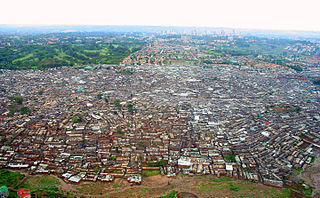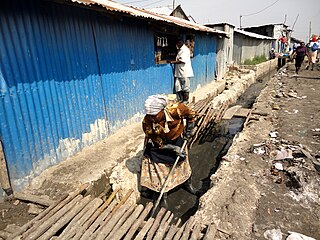
Kibera is a division of Nairobi Area, Kenya, and neighbourhood of the city of Nairobi, 6.6 kilometres (4.1 mi) from the city centre. Kibera is the largest slum in Nairobi, and the largest urban slum in Africa. The 2009 Kenya Population and Housing Census reports Kibera's population as 170,070, contrary to previous estimates of one or two million people. Other sources suggest the total Kibera population may be 500,000 to well over 1,000,000 depending on which slums are included in defining Kibera.

A flying toilet is a facetious name for a plastic bag that is used as a simple collection device for human faeces when there is a lack of proper toilets and people are forced to practise open defecation. The filled and tied plastic bags are then discarded in ditches or on the roadside. Associated especially with slums, they are called flying toilets "because when you have filled them, you throw them as far away as you can".
Raila is a part of Kibera slum in Nairobi. Other parts of Kibera include Laini Saba, Lindi, Makina, Kianda, Gatwekera, Soweto East, Kichinjio, Kisumu Ndogo, Makongeni and Mashimoni.

Hot Sun Foundation is a non-profit organization that works in Nairobi, Kenya with young people from urban slums and other marginalized communities of East Africa to train and expose their talents and potential on the world stage. Hot Sun Foundation trains youth in all aspects of filmmaking, from scriptwriting, camera, sound, pre production, budgeting, production, directing, editing, and marketing. Vision of Hot Sun Foundation: Social transformation through art and media Mission of Hot Sun Foundation: Identify and develop youth talent to tell their stories on film

Mukuru Kwa Njenga is a slum in the East of Nairobi, the capital of Kenya. It borders the Jomo Kenyatta International Airport to the north, Industrial Area business district to the south and other growing suburbs areas within Embakasi region such as Donholm Estate. It belongs to Embakasi South Constituency, but it extends into Makadara and Starehe constituencies. It is one of the largest slums in Nairobi. It stretches along the Nairobi/Ngong River, situated on waste lands in the industrial area of the city between the Outer Ring Road, North Airport Road and Mombasa road. Mukuru has villages namely; Mukuru kwa Reuben, Mukuru kwa Njenga, Sinai, Paradise, Jamaica, Kingstone, Mariguini, Fuata Nyayo and Kayaba. The population exceeds 100,000.
Laini Saba is a suburb of Nairobi, the capital of Kenya. It belongs to the major slum of Kibera. As for Lindi, another village within Kibera, its population is estimated at 100,000. Soweto East is another village belonging to Kibera. The price of water there clearly is above Nairobi average. A Laini Saba Primary School exists.
Soweto East is a part of Kibera slum in Nairobi. Its population has been estimated at 70,000 persons. Slum residents have to pay more than others for water. Other parts of Kibera include Laini Saba, Lindi, Makina, Kianda, Mashimoni, Gatuikira, Kisumu Ndogo and Siranga.
Soweto East is a part of major Kibera slum in Nairobi. A school KidStar Academy is in Soweto West. Other parts of Kibera include Soweto East, Laini Saba Lindi, Makina, Kianda, Mashimoni, Gatuikira, Kisumu Ndogo and Siranga.
Gatwekera (Gatuikira) is a part of Kibera slum in Nairobi. Its population likely exceeds 70,000. Water & Sanitation for the Urban Poor is active there. Many of its residents are Luo. Médecins Sans Frontières used to run a health center there. Other parts of Kibera include Laini Saba, Lindi, Makina, Kianda, Mashimoni, Soweto East, Kisumu Ndogo and Siranga.
Kangemi is a slum in Kenya located, like many other slums in Nairobi, on the outskirts of the city. It is bordered on the north by the middle-class neighborhoods of Loresho and Kibagare and Westlands on its west. Its southern border connects with Kawangware, another large slum and its eastern border connects to Mountain View, another middle class enclave. It is on the road connecting Nairobi with Naivasha. Kangemi likely has more than 100,000 residents. While it is a multi-ethnic slum, the largest group of residents consists of the Luhya tribe.
Kisumu Ndogo is a name given to "villages" that are part of two informal settlements in Nairobi, Kenya, Kibera and Korogocho. Kisumu Ndogo means little Kisumu.
Mashimoni is a part of Kibera slum in Nairobi. Mashimoni Primary School, Facing the Future School, Mashimoni Good Samaritan School for the Orphans (MAGOSO) and Mashimoni Squatters Schools exist. Many of its residents are Luhyas and Kambas. It is part of Langata Constituency. Other parts of Kibera include Laini Saba, Lindi, Makina, Kianda, Gatwekera, Soweto East, Kisumu Ndogo and Siranga.
Siranga is a part of Kibera slum in Nairobi. Its population is estimated at 150,000 residents. The Nairobi Christian Outreach Centre is in Siranga. Other parts of Kibera include Laini Saba, Lindi, Makina, Kianda, Gatwekera, Soweto East, Kisumu Ndogo, Mugumoini, Makongeni, Kichinjio and Mashimoni.
Mugumoini is a part of Kibera slum in Nairobi. A Mugumoini Primary School exists. It is part of Langata Constituency. Many residents are Luhyas. Mugumoini has a PCEA church. Other parts of Kibera include Laini Saba, Lindi, Makina, Kianda, Gatwekera, Soweto East, Kisumu Ndogo, Makongeni, Kichinjio and Mashimoni.
Kichinjio is a part of Kibera slum in Nairobi. Kichinjio has a New Adventure Secondary School and a Kicoshep Primary School. Furthermore, Kichinjio has a mosque. Other parts of Kibera include Laini Saba, Lindi, Makina, Kianda, Gatwekera, Soweto East, Kisumu Ndogo, Makongeni and Mashimoni.
Kambi Muru is a part of Kibera slum in Nairobi. It borders to Mashimoni, Lindi, Kisumu Ndogo and Makina. Kambi Muru is the site of Kibera Academy. It is also a part of the area of Christ the King Catholic Church. Other parts of Kibera include Laini Saba, Lindi, Makina, Kianda, Gatwekera, Soweto East, Kichinjio, Kisumu Ndogo, Makongeni and Mashimoni.
Sarang'ombe is a part of Kibera in Nairobi.Some parts of Sarang'ombe ward include Ayany Estate. It is part of Kibra Constituency. An Ushirika Health Centre is in Sarang'ombe. Other parts of Kibera include Laini Saba, Lindi, Makina, Kianda, Gatwekera, Soweto East, Kichinjio, Kisumu Ndogo, Makongeni and Mashimoni.
Shilanga is a part of Kibera slum in Nairobi. It has at least one church. It has a major Luo population. Other parts of Kibera include Laini Saba, Lindi, Makina, Kianda, Gatwekera, Soweto East, Kichinjio, Kisumu Ndogo, Makongeni and Mashimoni.
Kennedy Odede is a Kenyan social entrepreneur and author of a New York Times best-selling memoir. Odede serves as co-founder and CEO of Shining Hope for Communities (SHOFCO), a grassroots movement based in Nairobi, Kenya and New York, USA. SHOFCO works in urban slums across Kenya, setting up and running a free school for girls in the slum, making clean water and medical care accessible, and helping individuals start small businesses.